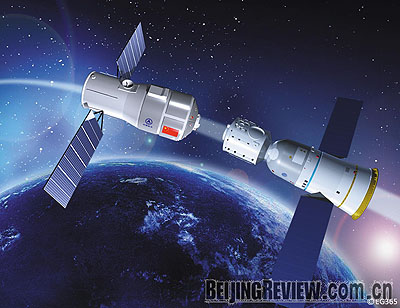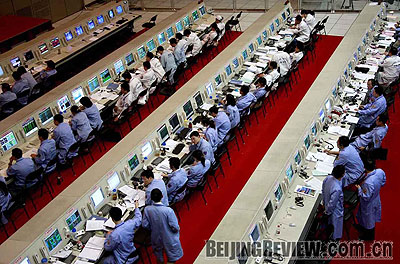| On February 27, audience of China Central Television was treated to a glimpse of their country's next space-age leap with a preview of the not-yet-complete Tiangong I space station. China's first space station is expected to be launched in late 2010.
 |
|
SPACE DOCKING: In the two years after Tiangong I is launched around 2010, three Shenzou spacecraft will dock with it at different times |
|

|
|
DEDICATION: Scientists working at the Beijing Aerospace Control Center | The same day, a spokesperson for China's manned space program told Xinhua that Tiangong I's development is moving forward along with the systems it will need once in space. A prototype of the space module, whose name means "palace in heaven," is almost complete and engineers have started research in the station's docking process.
"A space station is like a mansion in space that is assembled in its orbit," said Jiao Weixin, a professor in the School of Earth and Space Sciences at Peking University. The parts are being built on Earth and will be launched into orbit using large rockets, where robotic arms will assemble them.
Scientists hope the new station will provide a better platform for human beings to understand space and perform experiments.
"A spacecraft usually flies in space for a week or so. It has limited time to conduct scientific research," said Jiao. A space station, however, can stay in orbit for a long time and scientists can run various experiments and develop space products, he said.
Since a space laboratory is subject to almost no gravity and operates in a vacuum, it is ideal to conduct research in the life sciences and material sciences that cannot be done on Earth. Scientists can breed new crops, invent new drugs and create new materials, along with conducting research in astronomy, Earth observation and navigation.
While Tiangong I will serve as a residence and laboratory for visiting astronauts to conduct experiments, it will also be able to operate independently when there is no crew aboard. Spacecraft will be able to dock to ferry cargo and crew between Earth and the station.
Three steps into space
China's manned space program, which began in 1992, is being carried out in three stages, said Wang Zhaoyao, a spokesperson for China National Space Administration (CNSA).
During the first stage of the program, unmanned and manned spacecraft were sent into near-Earth orbit to conduct Earth observations and scientific experiments.
China independently developed a series of Shenzhou spacecraft. In November 1999, Shenzhou 1, China's first unmanned spacecraft was successfully launched. Three more successful unmanned missions followed, with Shenzhou 2 in 2001, and Shenzhou 3 and Shenzhou 4 in 2002.
The stage reached its end with the successful launch of China's maiden manned mission on October 15, 2003. Shenzhou 5 carried Chinese astronaut Yang Liwei to space, where he stayed in orbit for 21 hours. China is the third nation to launch a human into space.
The second stage of China's manned space program started with a manned space flight of Shenzhou 6 in 2005. Then on September 25, 2008, Shenzhou 7 spacecraft carried three crew members to the space. A highlight in this mission came on September 27, when an astronaut on aboard performed an extravehicular activity (EVA), the first ever space walk for a Chinese astronaut, which makes China the third country to have conducted an EVA, after the Soviet Union and the United States.
The second stage also includes space rendezvous and docking. China will put in orbit a "target vehicle" Tiangong I, and two bigger space laboratories Tiangong II and Tiangong III. Through these efforts, China will establish a fully equipped space engineering system.
After the expected 2010 launch of the 8.5-ton Tiangong I, three spacecrafts- Shenzhou 8, Shenzhou 9 and Shenzhou 10 - will dock at the space station in the following two years, said Qi Faren, the designer of Shenzhou 6 and Shenzhou 7 during a recent interview.
| 